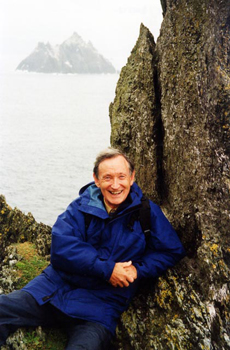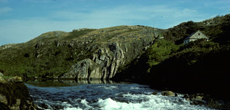




| Home | Features | Club Nights | Underwater Pics | Feedback | Non-Celebrity Diver | Events | 18 July 2025 |
| Blog | Archive | Medical FAQs | Competitions | Travel Offers | The Crew | Contact Us | MDC | LDC |

|

|
 
 |
 |
ISSUE 8 ARCHIVE - BEST DIVE, WORST DIVE, TREVOR NORTONBEST: Lough Hyne is one of the most beautiful lakes in Ireland, yet not a lake at all. Don't be fooled by the kingfishers and otters, it's an enclosed fragment of the sea. The tide rushes in and out like a cataract through a narrow channel. The torrent temporarily slackens when the water level inside the Lough matches that of the Atlantic Ocean outside. Although the flow reverses immediately, for fifteen minutes you can dive there.I was studying the behaviour of jewel anemones, which involved diving in the rapids at night. They were my first night dives. As the current waned, I slipped into the chill water to find myself caged by vertical stems of kelp. Between them, in caverns of darkness, were pairs of unblinking eyes. I felt like a child trapped at night in a cartoon jungle. The eyes hung there with nothing attached. They belonged to transparent shrimps. One turned sideways and even its eyes vanished. All I could see was luminous food passing through its gut. Dozens of worms and tiny crustaceans emerged from between the kelp 'roots' in search of something dead for dinner. The night was alive with insomniacs that hide away when the sun is up. |
 |
 |
As my eyes accommodated to the
gloom, I saw a swimming worm leaving
an iridescent wake. When I held my
hand in the flow, it became etched by a
constellation of cold stars. Blown sparks
collided with my facemask. These
swarms of tiny Noctiluca (nightlight) are
the silent fireworks of the sea. When I
dived at midnight in a cave close by,
my entire body became a glowing,
green spectre.
As the current grew, my dive mask began to tremble violently. I let myself go and was swiftly dragged downstream beyond the thrashing canopy of kelp into the opalescent underwater landscape of a creek. |
 |
|
There was a wrasse lying on its side on
the sand dozing. During the day wrasse
may be sociable, but at night they sleep
alone. In an aquarium, if you switch off
the light, they put themselves to bed.
I lay beside the wrasse and gazed up at the undulating surface of the sea where the moon continually separated and coalesced like a dancing amoeba. A jellyfish drifted between me and the moonlight and was instantly etched in silver. I became entranced by the waltzing moon and held my breath to listen to the sounds of the sea. Divers deafened by the sounds of their breathing and escaping bubbles should hold their breath and listen. They would hear the heartbeats of the ocean. At night, when shapes are lost in shadow, sounds come into their own. I heard the long sigh of water flowing down the rapids, the lisping waves easing round a reef and the soft rattle from the shore as the undertow retrieved a pebble a wave had donated only seconds before. Note: Lough Hyne is a nature reserve and a license is needed to dive there. |
||
|
WORST: The southern Arabian coast is one of
the least studied in the world. I was
invited to assess the marine resources
of the Peoples Democratic Republic
of Yemen. I should have known better.
'Democratic' in the name is always a
bad sign.
It wasn't a good time. To commemorate an anniversary of British rule in Aden the TV showed endless old newsreels of British soldiers beating up the locals. To make matters worse, the vice president had just been assassinated in what was said to be 'an imperialist western plot'. After admiring an arc of bullet holes decorating the wall in the airport I flew to the Hadramawt, the hottest coast in the world. While I was there the temperature never dropped below 40°C with 80% humidity. I hoped the locals would be friendly, but on arrival armed soldiers stamped on the film from my camera. South Yemen was fiercely tribal. The chant of one tribe went: 'We are the sparks of Hell; he who defies us will be burned'. There were three guns to each inhabitant and westerners were kidnapped almost every week. Kalashnikovs were on sale in the market. I considered getting one. As a guest of the State I stayed at Government House. It wasn't a fading mansion from the last flush of Empire, but a billet for council workers. I had a decrepit air-conditioned trailer in the yard. Every eight minutes the motor exploded into life or shuddered to a halt with a simulated burst of machine gun fire. As assassins might well kick down the door and spray my bed with bullets, I slept fitfully. A driver had been ordered to take me to several shores each day. I made an adequate collection at the first site, a perfunctory one at the second, but the third had vanished beneath the waves. So I went snorkelling. The tide pools swarmed with sea snakes. Venomous snakes on land are one thing, but those unseen in totally opaque water are a different proposition. Their bite is ten times more toxic than that of a cobra. If bitten, you suffer paralysis from the legs to the jaw, plus vomiting, convulsions and death. There was no antiserum. Fortunately, most sea snakes are docile and rarely bite unless provoked, except in the breeding season when they are 'vicious and aggressive'. Unfortunately, this was the breeding season when they migrate inshore in large numbers. One observer reported 'a solid mass composed of millions of snakes twisted thickly together forming a line about ten feet wide and sixty miles long'. An expert wrote that 'most bites occur when wading in muddy shallow waters.' I was snorkelling in the muddy shallows. Visibility was zero. I was blindly feeling for seaweeds and frequently feeling imaginary serpents. I have rarely enjoyed a dive less. Except perhaps in Pakistan when diving, again in opaque water, beside the outfall from what turned out to be a dilapidated nuclear power station. |
 | |
Previous article « Underwater Photography Next article » Rob's World - A Diver's Guide to Marine Life Back to Issue 8 Index | ||